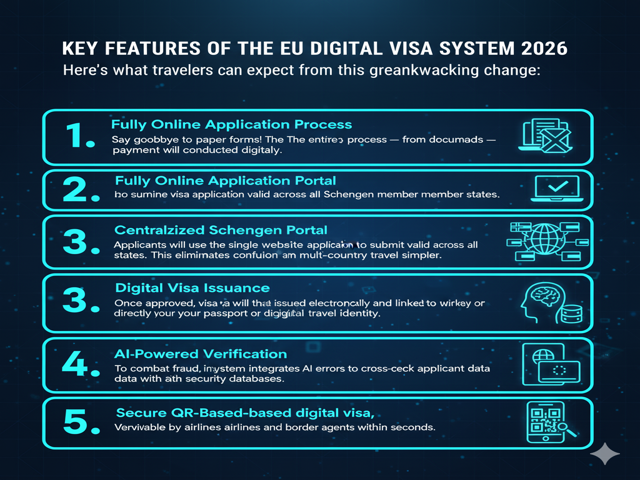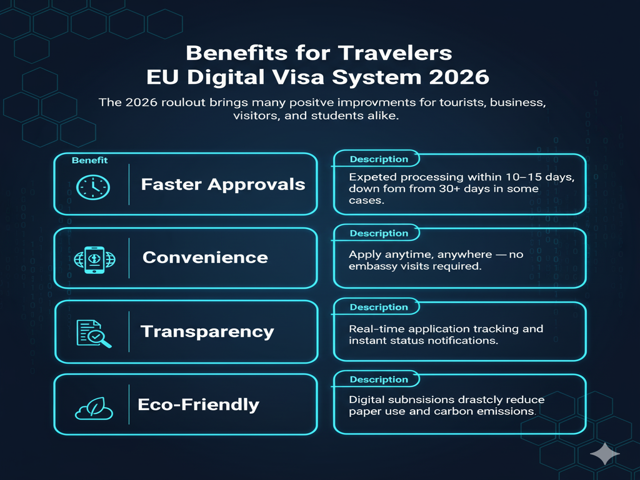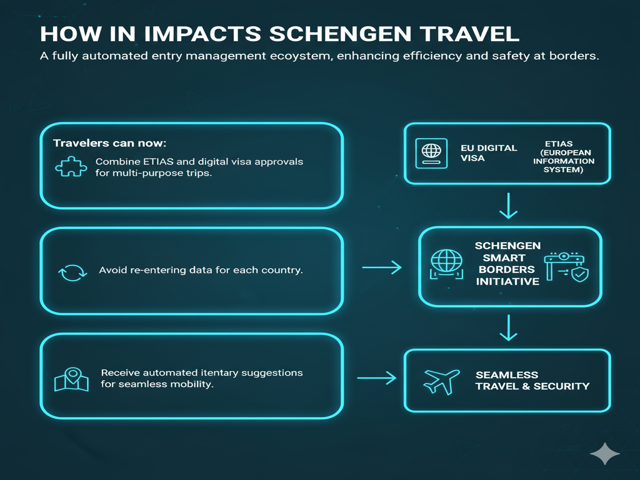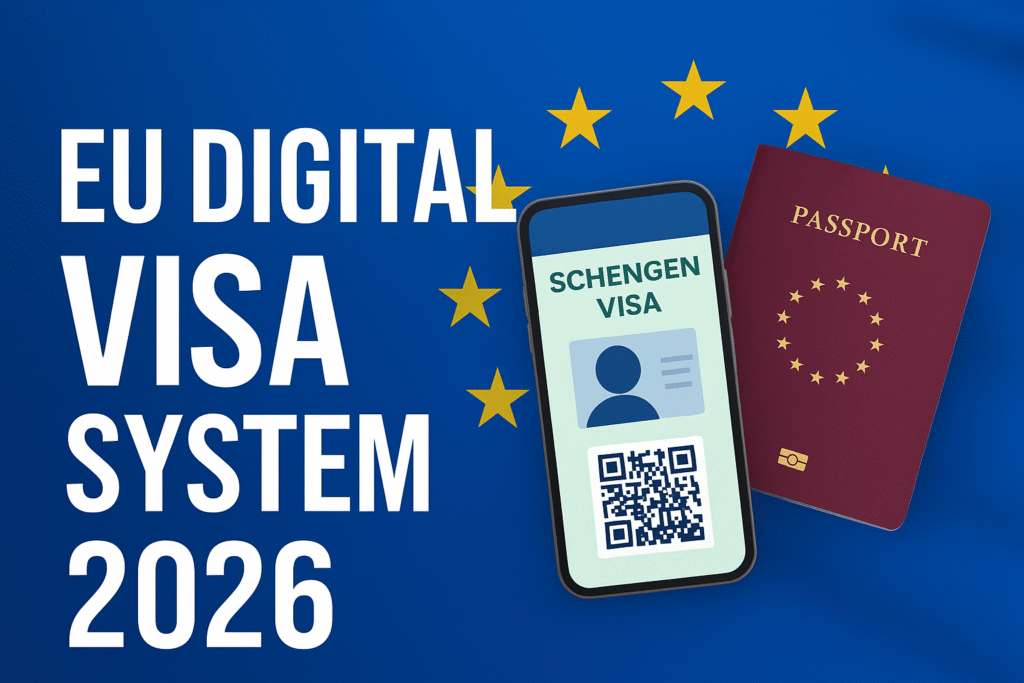The Future of Travel to Europe
The European Union (EU) is embracing a new era of digital transformation with the launch of the EU Digital Visa System 2026. This landmark innovation will reshape how millions of travelers apply for, manage, and receive their Schengen visas.
In an increasingly digital world, paper-based visa processes are quickly becoming outdated. The EU aims to streamline travel, reduce waiting times, and improve security—all through a unified digital platform accessible worldwide.
Why the EU is Going Digital
For years, Schengen visa applicants faced inconsistent procedures, manual paperwork, and long embassy queues. The new EU Digital Visa System 2026 addresses these issues by offering:
- A single online portal for all 29 Schengen countries.
- Faster processing times, reducing approval delays.
- Secure data management through centralized digital encryption.
- Automated updates and status tracking for applicants.
According to the European Commission, this transformation is part of a broader initiative to modernize EU border systems and support smart, secure travel by 2030.
Key Features of the EU Digital Visa System 2026
Here’s what travelers can expect from this groundbreaking change:

1. Fully Online Application Process
Say goodbye to paper forms!
The entire visa process — from document uploads to payment — will be conducted digitally.
2. Centralized Schengen Portal
Applicants will use a single website to submit applications valid across all Schengen member states. This eliminates confusion and makes multi-country travel simpler.
3. Digital Visa Issuance
Once approved, the visa will be issued electronically and linked directly to your passport chip or digital travel identity.
4. AI-Powered Verification
To combat fraud and errors, the EU system integrates AI screening tools to cross-check applicant data with security databases.
5. Secure QR-Based Access
Travelers will receive a QR code-based digital visa, verifiable by airlines and border agents within seconds.
Benefits for Travelers EU Digital Visa System 2026
The 2026 rollout brings many positive improvements for tourists, business visitors, and students alike.

| Benefit | Description |
|---|
| Faster Approvals | Expected processing within 10–15 days, down from 30+ days in some cases. |
| Convenience | Apply anytime, anywhere — no embassy visits required. |
| Transparency | Real-time application tracking and instant status notifications. |
| Eco-Friendly | Digital submissions drastically reduce paper use and carbon emissions. |
How It Impacts Schengen Travel
The EU Digital Visa System 2026 supports the EU’s Smart Borders initiative and will complement the ETIAS (European Travel Information and Authorization System).
Together, they form a fully automated entry management ecosystem, enhancing efficiency and safety at borders.

Travelers can now:
- Combine ETIAS and digital visa approvals for multi-purpose trips.
- Avoid re-entering data for each country.
- Receive automated itinerary suggestions for seamless mobility.
For Non-EU Applicants
If you’re from a non-Schengen country that requires a visa, you’ll benefit most.
Here’s what you need to know:
- You’ll apply via the EU Visa Portal.
- Supporting documents (bank statements, invitation letters, insurance) are uploaded online.
- Face-to-face interviews may still be required for first-time applicants, but renewals will be automatic.
Data Security and Privacy for EU Digital Visa System 2026
Digital transformation raises questions about data protection.
The EU reassures applicants that the system will follow GDPR-compliant protocols, ensuring:
- Encrypted storage of biometric and personal data.
- Access control for authorized visa officers only.
- Secure data sharing between Schengen states.
Transition Timeline (2024–2026)
| Year | Development Stage | Key Update |
|---|---|---|
| 2024 | System design & testing | Prototype completion by EU-LISA |
| 2025 | Pilot phase | Limited rollout in 5 countries |
| 2026 | Full implementation | Available across all Schengen states |
Transition Timeline (2024–2026)
| Year | Development Stage | Key Update |
|---|---|---|
| 2024 | System design & testing | Prototype completion by EU-LISA |
| 2025 | Pilot phase | Limited rollout in 5 countries |
| 2026 | Full implementation | Available across all Schengen states |
Source: European Commission: EU Digital Visa Proposal 2026
FAQs about the EU Digital Visa System 2026
Q1: Will paper visas still be accepted after 2026?
No, paper stickers will be phased out. The digital visa will replace all physical documents.
Q2: What happens if my application is rejected?
Applicants can appeal online through the same digital portal, streamlining dispute resolution.
Q3: Is biometric data still required?
Yes, fingerprints and a photo are needed — but they can be stored for reuse in future applications.
Q4: Does this system affect ETIAS-exempt travelers?
No. ETIAS travelers remain visa-free but will benefit indirectly from faster border checks.
Q5: Which countries will start first?
Early adopters include Germany, France, Spain, Italy, and the Netherlands.
Related Post: UK ETA 2025: How the New Electronic Travel Authorization Works
Advise Agent: A Smarter, Simpler Future for EU Travel
The EU Digital Visa System 2026 is more than a modernization — it’s a revolution in how the world connects with Europe.
By merging technology, security, and simplicity, the EU sets a new global standard for digital border management.
Whether you’re a frequent traveler or a first-time visitor, the future of European travel is just a few clicks away.



